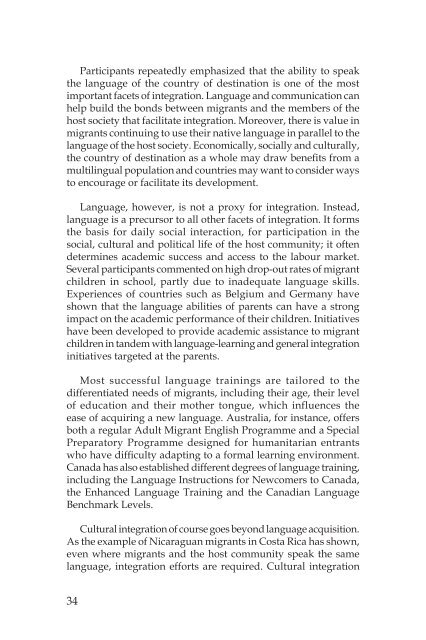Link - IOM Publications - International Organization for Migration
Link - IOM Publications - International Organization for Migration
Link - IOM Publications - International Organization for Migration
Create successful ePaper yourself
Turn your PDF publications into a flip-book with our unique Google optimized e-Paper software.
Participants repeatedly emphasized that the ability to speak<br />
the language of the country of destination is one of the most<br />
important facets of integration. language and communication can<br />
help build the bonds between migrants and the members of the<br />
host society that facilitate integration. Moreover, there is value in<br />
migrants continuing to use their native language in parallel to the<br />
language of the host society. Economically, socially and culturally,<br />
the country of destination as a whole may draw benefits from a<br />
multilingual population and countries may want to consider ways<br />
to encourage or facilitate its development.<br />
language, however, is not a proxy <strong>for</strong> integration. Instead,<br />
language is a precursor to all other facets of integration. It <strong>for</strong>ms<br />
the basis <strong>for</strong> daily social interaction, <strong>for</strong> participation in the<br />
social, cultural and political life of the host community; it often<br />
determines academic success and access to the labour market.<br />
Several participants commented on high drop-out rates of migrant<br />
children in school, partly due to inadequate language skills.<br />
Experiences of countries such as Belgium and Germany have<br />
shown that the language abilities of parents can have a strong<br />
impact on the academic per<strong>for</strong>mance of their children. Initiatives<br />
have been developed to provide academic assistance to migrant<br />
children in tandem with language-learning and general integration<br />
initiatives targeted at the parents.<br />
Most successful language trainings are tailored to the<br />
differentiated needs of migrants, including their age, their level<br />
of education and their mother tongue, which influences the<br />
ease of acquiring a new language. Australia, <strong>for</strong> instance, offers<br />
both a regular Adult Migrant English Programme and a Special<br />
Preparatory Programme designed <strong>for</strong> humanitarian entrants<br />
who have difficulty adapting to a <strong>for</strong>mal learning environment.<br />
Canada has also established different degrees of language training,<br />
including the language Instructions <strong>for</strong> Newcomers to Canada,<br />
the Enhanced language Training and the Canadian language<br />
Benchmark levels.<br />
Cultural integration of course goes beyond language acquisition.<br />
As the example of Nicaraguan migrants in Costa Rica has shown,<br />
even where migrants and the host community speak the same<br />
language, integration ef<strong>for</strong>ts are required. Cultural integration<br />
4

















